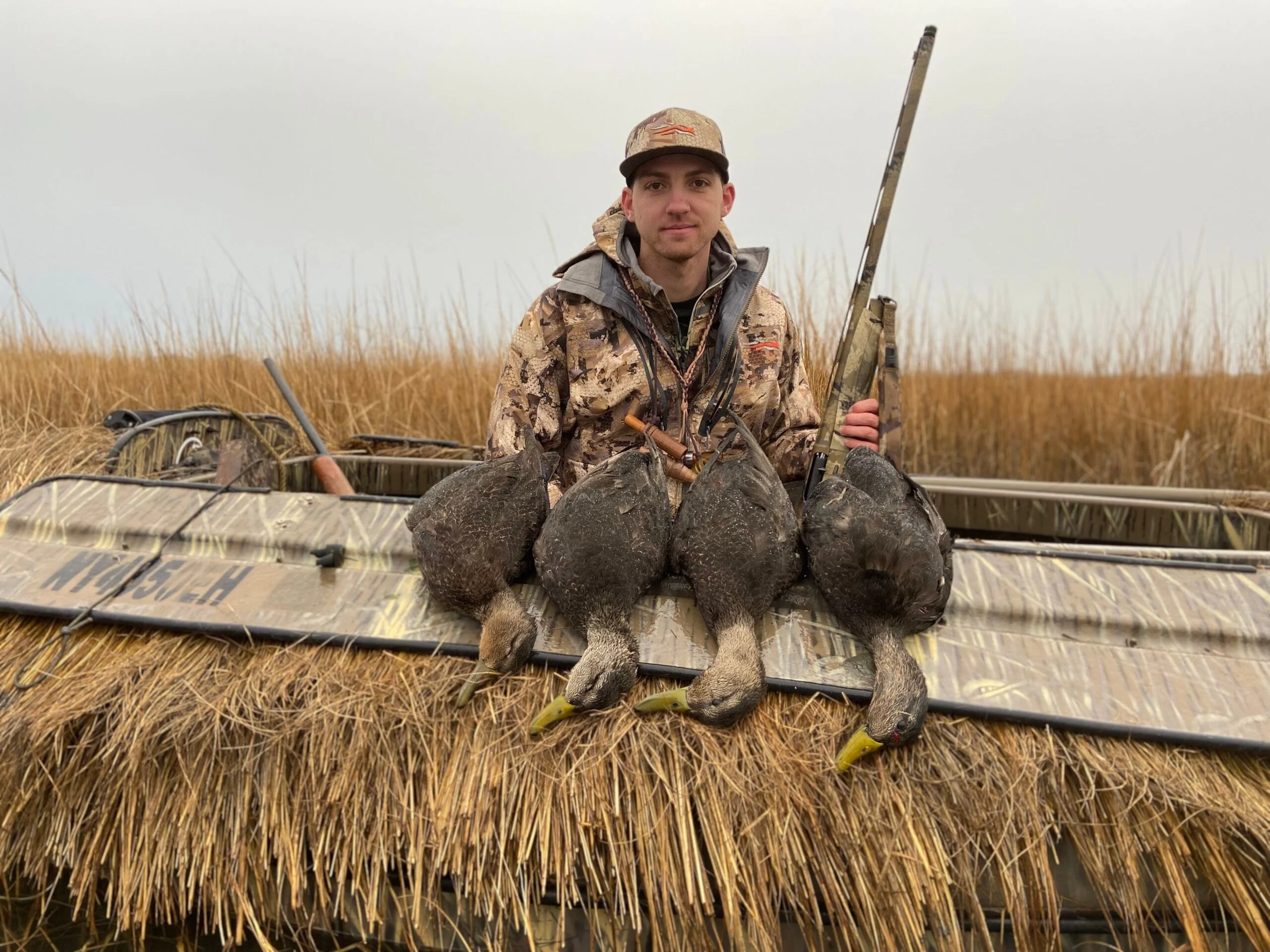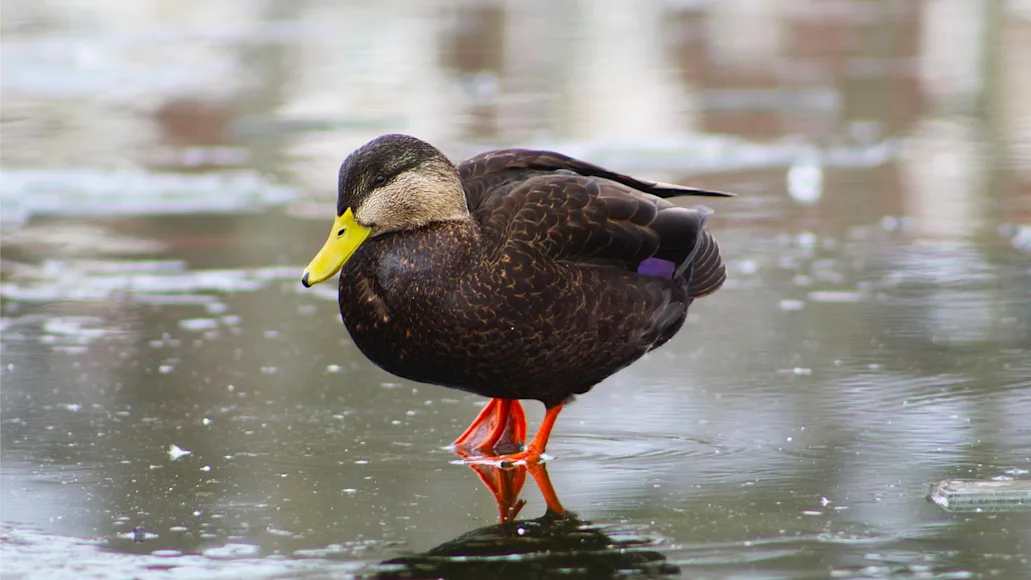For the majority of waterfowl hunters across the country, the American black duck is a once-in-a-lifetime bird. A close cousin to the Mallard, the black duck will be forever associated with the Atlantic flyway. They can be found in freshwater lakes, ponds, rivers, and wetlands, but these birds have a keen affinity for coastal salt marshes. While the black duck is an east-coast icon, it also ranges westward to the Mississippi flyway.
Known as one of the wariest and hardest-to-kill of all the puddle ducks, hunters must have excellent concealment, good decoys, and a bit of luck to harvest a black duck. While these birds can be found all along the entire eastern seaboard, the highest wintering populations range from the salt marshes of Long Island and New Jersey down to the Carolinas. Here’s everything else you need to know in order to identify, hunt, and cook the American black duck.

Appearance and Calls
The black duck is often mistaken for a hen mallard on the wing. But a closer side-by-side comparison will quickly reveal the black duck’s much darker chocolate-brown feathers. It is also one of the few ducks where the hens and drakes are almost identical. Males and females both wear dark coats of feathers and have grayish heads. The only way to tell the difference between hens and drakes is by the color of their bills—drakes have bright yellow bills, and hens have olive bills. Black ducks appear especially dark in flight, but the underside of their wings are white—clearly visible to hunters when birds flare out of the decoys. Unlike mallards, black ducks have a dark blue speculum with black borders.
Black ducks are often found mixed in with flocks of mallards. They also make very similar sounds to their mallard cousins. The hens quack, and the drakes have a high, quiet, nasal quack. Drakes also have a high-pitched whistle they reserve for breeding time.
Feeding Habits
Black ducks are most commonly associated with salt marshes, but they live inland, too, often favoring out-of-the-way beaver ponds, wooded swamps, and marshy wetlands. They are dabbling ducks, tipping up to feed on aquatic plants and invertebrates. Inland, they feed on pondweeds and sedges, and they will forage for seeds, berries, and even roots and leaves of some plants. They will also feed in dry agricultural fields on waste grains such as corn. On tidal marshes, black ducks turn more carnivorous, eating mussels, clams, snails, and crustaceans.

Breeding
Unlike many other species of waterfowl, black ducks don’t wait until late winter or early spring to start pairing up. In the fall, drakes will begin to find hens. Courtship starts with head-bobbing and, if that goes well, escalates to swimming, bumping, nipping, and chasing both on the water and in the air, with the drake as the aggressor. Black ducks pair monogamously for the season, and sometimes, the same hen and drake will pair year after year.
Black ducks breed from the upper Mississippi River north to Manitoba and then east across Canada and the United States. According to Ducks Unlimited, the highest breeding densities are found in Maine and Nova Scotia, where they breed around fresh and saltwater wetlands. Hens make a nest in the grass by scooping a depression in the ground. They usually lay six to 14 eggs. The male defends the nest until incubation is well along the way, then it wanders off and eventually leaves the hen with the young. As with all waterfowl, American black ducks molt in the summer and grow new feathers in time to stage for fall migrations.
Fall Migration
The majority of black ducks are found in the Atlantic flyway, with some birds scattered across the Mississippi flyway. These birds migrate from the northern U.S. and Canada to the mid-Atlantic coast in the United States. The highest wintering populations are found in coastal marshes between Long Island and the Carolinas. While these ducks are capable of longer migration flights, they are hardy birds, and those that live on the coasts where the moving salt water rarely freezes don’t have to migrate as far. Inland black ducks travel further to find suitable wintering grounds. In either case, they travel in small flocks of 20-30 birds as they migrate.

Conservation Concerns
Although still widespread, black ducks are in a population decline. Between the 1950s and the 1980s, their numbers fell by fifty percent, according to the U.S. Fish and Wildlife Service. Currently, numbers are stable but remain below the long-term average. This stabilization in the population allowed the Atlantic flyway daily bag limit to be increased from one to two birds in 2018. This regulation change came after 30 years of a one bird daily bag limit. The Mississippi flyway also has a daily black duck limit of two birds.
Black ducks face many of the same issues as most waterfowl species, including loss of wintering and breeding habitat, pollution, and urbanization. Biologists have also determined that crossbreeding with mallards contributes to a decline in overall black duck numbers.
Black Duck Hunting
You have to love black duck hunting to specialize in it because limits are low, and consistently killing these birds is a lot of work in the coastal marshes where they are traditionally pursued. I grew up hunting the salt marshes of Long Island’s south shore, where the black duck is king. Hunting these birds along the coast usually requires grass boats or sneak boxes, a reliable outboard motor, and an intricate understanding of the tides.
Hunters will time their shoots around falling tides, which expose the marsh banks with food for the ducks. Many times, the falling tide, regardless of the time of day, will provide the most bird activity and best hunting. Black ducks usually feed as singles, pairs, or small groups. As the tide rises, ducks will start to leave the salt marsh and fly to freshwater ponds and creeks to loaf.
Getting set up at half tide and hunting through the drop will yield the best chance for a black duck limit. However, hunters must be careful of getting stuck in the marsh as the tide recedes. These birds were traditionally gunned over small spreads of hand-carved cork decoys. Nowadays, hunters still hunt over small spreads, but use much more modern designs, like these Avian X fully flocked decoys. Calling should be minimal on salt marsh hunts, especially when birds are working in close. Black ducks have a reputation for being extremely wary and difficult to finish over the decoys. The slightest sign of movement or something out of place can flare birds at distances that would surprise you. An excellent hide is absolutely critical to success.
In certain areas of the Northeast, it is common to kill black ducks in freshwater. During New York’s early season, I will often see and kill black ducks in freshwater marshes and wetlands. In these scenarios, they are often mixed in with flocks of mallards, and good identification skills will help differentiate the birds in the air. For freshwater hunts, I usually throw out two Avian X black duck decoys mixed in with my spread of mallards and wood ducks. For salt marsh hunts, I run a rig of six to eight Avian X decoys with a pair of mallards set off to the side.

Cooking
Black ducks vary in taste depending on where they live and what they have been eating. Cook one that’s been living in freshwater and eating seeds or, even better, agricultural waste grains, and you won’t be able to tell it apart from a mallard. Those inland birds can be plucked and roasted or cooked any other way you might prepare a mallard. They are delicious.
Birds taken on the coast, though, can be a different story. If they have been living on crustaceans and other small marine animals, they may not taste as good. Any strong, fishy flavors will largely accumulate in the fat and skin. Skin your birds, trim off fat, and soak them in brine overnight before cooking. This will help tame the salty taste of these coastal birds.



